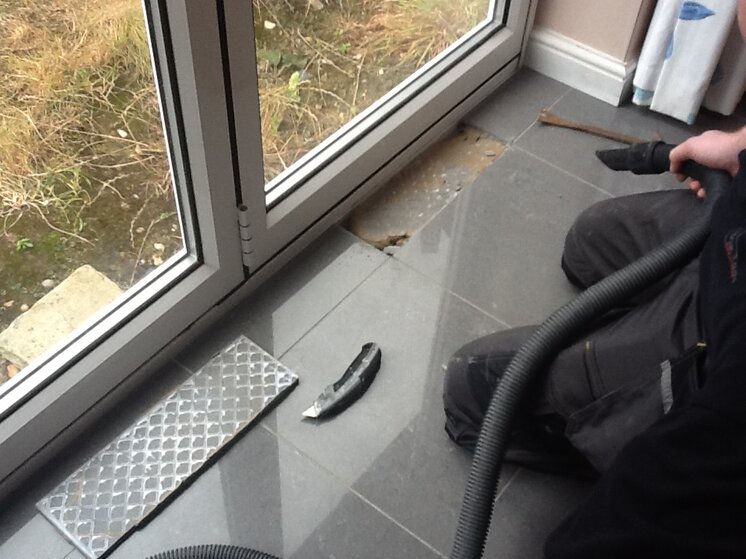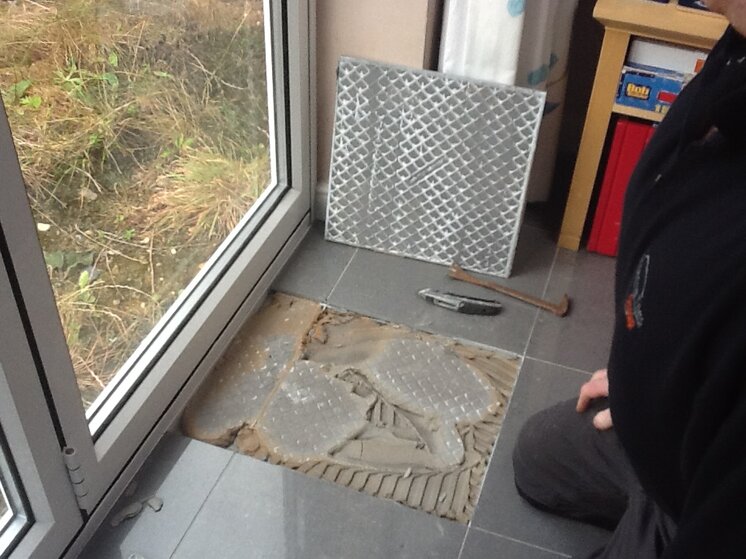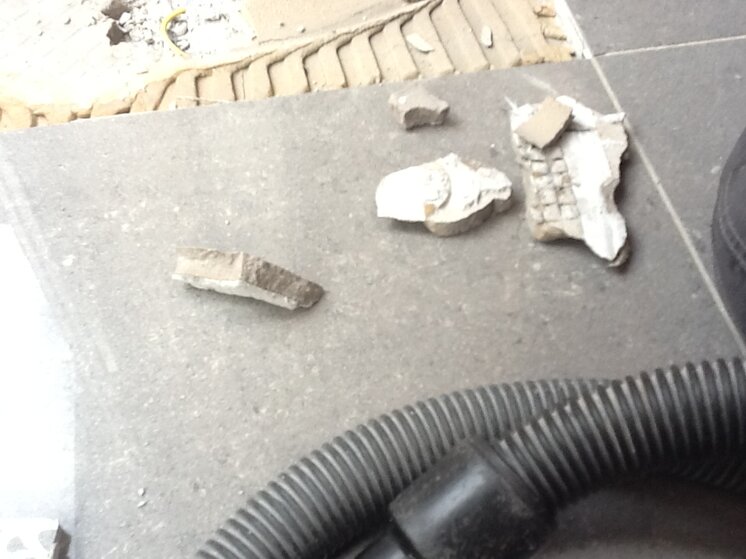U
Unregistered
I hope somebody can offer us some advice. We had an extension built last spring and have been experiencing problems with the tiled floor since about August/September last year, getting progressively worse.
Our new porcelain tiled floor is lifting in places, sounds hollow in others, and has lots of areas where the grout has come out of the joints. I'll try and give as much info as possible to see if you can offer some advice.
Porcelain tiles are porcelanosa 60x60 and are laid to the existing kitchen & utility floor (previous tiles removed), floor below the tiles is a concrete screed. New floor to the extension that is also tiled is concrete screed (but obviously far newer as it was laid as part of the build). Total area tiled was approx. 30m2
There is also UHF involved (electric cable mat 200w varme system).
As far as I am aware the "layers" above the concrete screed are as follows;
1) Self levelling compound applied to the join between the old and new floor, carried out by the builder, no idea of make/type.
1) Varme 6mm tilebacker board laid to entire floor surface to be tiled (laid with adhesive, no idea of the make or type, in some case screwed down in places, can't remember where, just that the builder had to do this). Carried out by the builder.
2) Varme supplied primer was then applied to the areas to have UFH (2 mats, 1 was 6m2, the other was 12m2) cable mat, floor probes and programmers fitted, not commisioned, as the consumer unit this was wired to was not yet connected to the main consumer unit (all done by our electrician, as recommended by the builder).
3) The same day as 2) above the builder applied an adhesive over the cable mat and we were instructed to only walk on the floor if absolutely necessary and not in shoes, needless to say we didn't enter the room! Do not know make or type of adhesive used.
4) The following day to 3) the tilers laid & grouted the floor, I am told that they used Granfix adhesive and grout but do not know the type. We were told not to clean the grout off the floor, if walking on the floor tread on the centres, but if at all possible leave for 4 hours, which we did (overnight i recall). We did not wash the floor for approx. 1 week. The tiler was employed by the builder.
5) The UFH was not connected up for four weeks after fitting (electrician on holiday followed by us going on holiday). When it was turned on the electricians manually set the the UFH to a floor temperature of 17 degrees. We did not begin to adjust the temperature for a further 12 weeks.
Around 2-3 months after the floor was laid I started to notice the odd popping noise on some of the tiles, particularly if you stood on the far edges of the tile & tried to "rock" it. Grout began to become loose in quite a few areas (spacers exposed), culminating in a tile at the entrance to the kitchen becoming completely loose (the thresher & skirting are all that is holding it in place) in early January, there is no UFH beneath this tile.
Needless to say other tiles are starting to make more popping noises or you can almost feel them "flexing" (one by the cooker, right next to the plinth, again no UFH at this point, told it was fitted approx 10cm out from the plinth), some in the middle of the floor, some at the perimeter.. The builder was called who came to have a look, had no idea so got the tiler back (not the actual tiler but the guy whose company it is). Tiler contacted Granfix, who apparently asked for photos and a sample, which we duly provided. The tiler removed one tile, chipped off the tile adhesive which was grey in colour with an orange tinge around the edges, took some photos (I didn't which I am now regretting) & sent to Granfix for tests. The tiler took our address and told us that Granfix would probably write to us direct with their findings (they didn't). He replaced the tile (we had a few spare) but it was obviously a few mm higher than all the other tiles.
We were subsequently told some 4-6 weeks later by the builder that the tiler had been advised (verbally) by Granfix that the adhesive had failed, but were then told some weeks after that Granfix were now stating that the issue is due to thermal shock (the inference being we turned the heating on too soon before the floor had cured, how long does it need??) but that the tiler has offered to replace the tiles at his cost (tiles alone are approx. £1300). We are concerned that the UFH could get damaged in the removal of the tiles & associated adhesive, our floor level increases (this is not an option, the plinth is aluminium so can't be simply cut down, plus we tiled under the appliances to ensure that we could get them out and are not sure if this will give us issues when we subsequently refit them) or worse still there is a problem further down the "layers" that reappears after the floor has been refitted.
It is fair to say we are at the mercy of the builder and his tiler and have no idea what the likely cause is, from the above information does it sound like we have caused the thermal shock or are there others questions we should be asking of the builder/tiler?
Any advice is truly welcomed.
Our new porcelain tiled floor is lifting in places, sounds hollow in others, and has lots of areas where the grout has come out of the joints. I'll try and give as much info as possible to see if you can offer some advice.
Porcelain tiles are porcelanosa 60x60 and are laid to the existing kitchen & utility floor (previous tiles removed), floor below the tiles is a concrete screed. New floor to the extension that is also tiled is concrete screed (but obviously far newer as it was laid as part of the build). Total area tiled was approx. 30m2
There is also UHF involved (electric cable mat 200w varme system).
As far as I am aware the "layers" above the concrete screed are as follows;
1) Self levelling compound applied to the join between the old and new floor, carried out by the builder, no idea of make/type.
1) Varme 6mm tilebacker board laid to entire floor surface to be tiled (laid with adhesive, no idea of the make or type, in some case screwed down in places, can't remember where, just that the builder had to do this). Carried out by the builder.
2) Varme supplied primer was then applied to the areas to have UFH (2 mats, 1 was 6m2, the other was 12m2) cable mat, floor probes and programmers fitted, not commisioned, as the consumer unit this was wired to was not yet connected to the main consumer unit (all done by our electrician, as recommended by the builder).
3) The same day as 2) above the builder applied an adhesive over the cable mat and we were instructed to only walk on the floor if absolutely necessary and not in shoes, needless to say we didn't enter the room! Do not know make or type of adhesive used.
4) The following day to 3) the tilers laid & grouted the floor, I am told that they used Granfix adhesive and grout but do not know the type. We were told not to clean the grout off the floor, if walking on the floor tread on the centres, but if at all possible leave for 4 hours, which we did (overnight i recall). We did not wash the floor for approx. 1 week. The tiler was employed by the builder.
5) The UFH was not connected up for four weeks after fitting (electrician on holiday followed by us going on holiday). When it was turned on the electricians manually set the the UFH to a floor temperature of 17 degrees. We did not begin to adjust the temperature for a further 12 weeks.
Around 2-3 months after the floor was laid I started to notice the odd popping noise on some of the tiles, particularly if you stood on the far edges of the tile & tried to "rock" it. Grout began to become loose in quite a few areas (spacers exposed), culminating in a tile at the entrance to the kitchen becoming completely loose (the thresher & skirting are all that is holding it in place) in early January, there is no UFH beneath this tile.
Needless to say other tiles are starting to make more popping noises or you can almost feel them "flexing" (one by the cooker, right next to the plinth, again no UFH at this point, told it was fitted approx 10cm out from the plinth), some in the middle of the floor, some at the perimeter.. The builder was called who came to have a look, had no idea so got the tiler back (not the actual tiler but the guy whose company it is). Tiler contacted Granfix, who apparently asked for photos and a sample, which we duly provided. The tiler removed one tile, chipped off the tile adhesive which was grey in colour with an orange tinge around the edges, took some photos (I didn't which I am now regretting) & sent to Granfix for tests. The tiler took our address and told us that Granfix would probably write to us direct with their findings (they didn't). He replaced the tile (we had a few spare) but it was obviously a few mm higher than all the other tiles.
We were subsequently told some 4-6 weeks later by the builder that the tiler had been advised (verbally) by Granfix that the adhesive had failed, but were then told some weeks after that Granfix were now stating that the issue is due to thermal shock (the inference being we turned the heating on too soon before the floor had cured, how long does it need??) but that the tiler has offered to replace the tiles at his cost (tiles alone are approx. £1300). We are concerned that the UFH could get damaged in the removal of the tiles & associated adhesive, our floor level increases (this is not an option, the plinth is aluminium so can't be simply cut down, plus we tiled under the appliances to ensure that we could get them out and are not sure if this will give us issues when we subsequently refit them) or worse still there is a problem further down the "layers" that reappears after the floor has been refitted.
It is fair to say we are at the mercy of the builder and his tiler and have no idea what the likely cause is, from the above information does it sound like we have caused the thermal shock or are there others questions we should be asking of the builder/tiler?
Any advice is truly welcomed.



